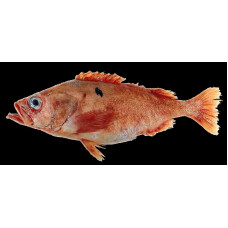Latin name
Sebastes alutus
Other names
Pacific rockfish, rose fish, red bream, red perch.
Identification
The body is elongated, compressed at the sides. The head is large, with ridges, covered with scales. There are supraorbital and postorbital spines. The lower jaw protrudes forward at the end of the symphysial tubercle. Vertebrae: 26.
Features of fish fins
The dorsal fin is long with 13 barbed and 13-16 soft rays. Anal fin with 3 barbed and 7-9 soft rays. Caudal fin with a small notch.
Fish colouring
The body colour is red. There are three dark grey patches along the base of the dorsal fin.
Distribution
Inhabits the North Pacific Ocean, where its range extends from Honshu Island in Japan to Cape Navarin in the Bering Sea, although it is absent from the Sea of Okhotsk, through the Aleutian Islands from Pat Main Bank to Bowers Bank, and south along the west coast of North America to Los Jollas, California. Jolla in California.
Habitat
A gregarious benthic-pelagic marine fish. Juveniles up to 1 year of age live in near-surface water layers near the coast. The transition to a benthic-pelagic lifestyle occurs at the age of 1-2 years. At the age of 3, they move to deeper waters of the continental shelf. Adults prefer areas of the outer part of the shelf and the continental slope. They can be found at depths of up to 825 m, but most commonly at depths of 150 to 200 m.
Size
Maximum body length 53 cm, mass up to 2.1 kg. Maximum life expectancy is 103 years.
Behavior
In summer, adults inhabit shallow depths, between 150 and 300m. In autumn, fish appear to migrate further from the coast to depths of ~300-420 m. They inhabit these deeper depths until around May, when they return to their shallower summer distribution.
Often rises from the bottom at night to feed, apparently following the migrations of euphausiids.
Food and feeding habits
Pacific Ocean perch are primarily planktivorous. Examination of the stomachs of 600 juveniles showed that they fed on an equal mixture of calanoids, copepods and krill. Larger juveniles and adults fed mainly on krill and to a lesser extent on copepods, amphipods and mysids.
Reproduction
First matures at 4-10 years of age with a body length of 22-25 cm. Age at maturity depends on the level of fishing pressure on the population. Fertilisation is internal and occurs in autumn. Sperm is retained inside the female for 2 months before fertilising the eggs. Hatching occurs inside the female, larvae hatch in April-May. Fecundity ranges from 2 to 350 thousand larvae. Reproductive capacity does not change in old individuals.
The larvae are thought to be pelagic, drifting with the current.
Postlarval and early yearling juveniles have been identified in coastal surface waters of the GOA, suggesting that this may be the preferred habitat for this life stage. A transition to a benthic life style may occur within the first year. Small fish are likely to live close to shore in very rocky areas with high topography, and by the age of 3 they begin to migrate to the deeper coastal waters of the continental shelf. As they grow, they continue to migrate inland, eventually reaching the continental slope where they reach maturity.
Fishing
A valuable commercial species. The fishery is conducted with multi-depth trawls.
Relationship with a person
The flesh of this fish has a good flavour.
| Classification | |
| Phylum | Chordata |
| Class | Actinopterygii |
| Squad | Scorpaeniformes |
| Family | Scorpaenidae |
| Genus | Sebastes |
| Species | S. alutus |
| Features | |
| Conservation status | Least Concern |
| Habitat | Pelagic |
| Life span, years | 103 |
| Maximum body weight, kg | 2,1 |
| Maximum length, cm | 53 |
| Sailing speed, m/s | No information |
| Threat to people | Edible |
| Way of eating | Planktonophage |
Pacific ocean perch
Tags: pacific ocean perch


